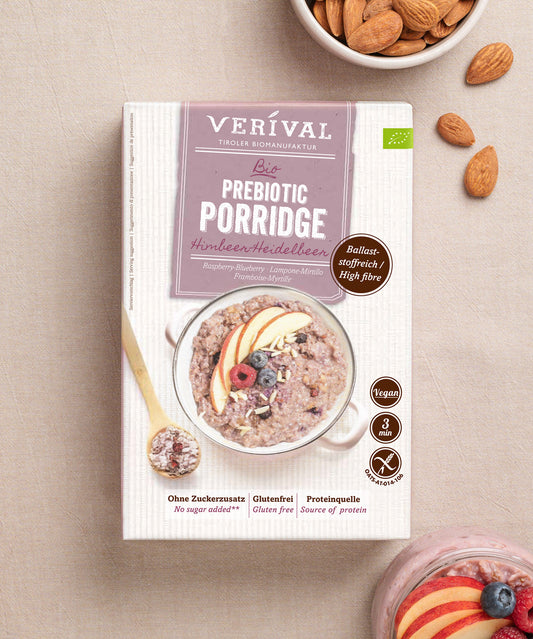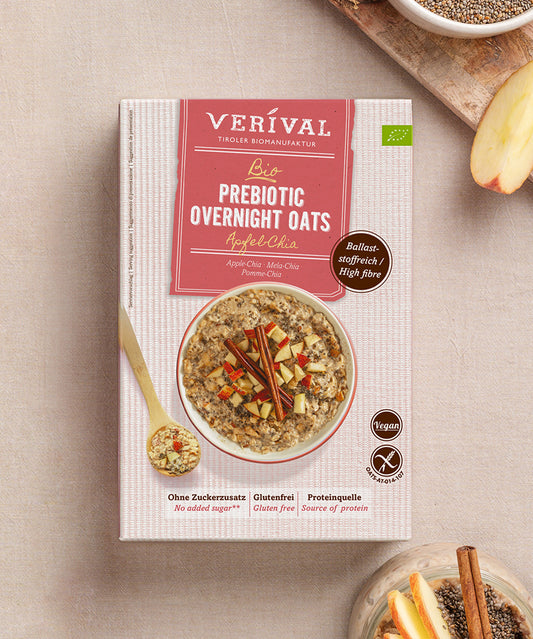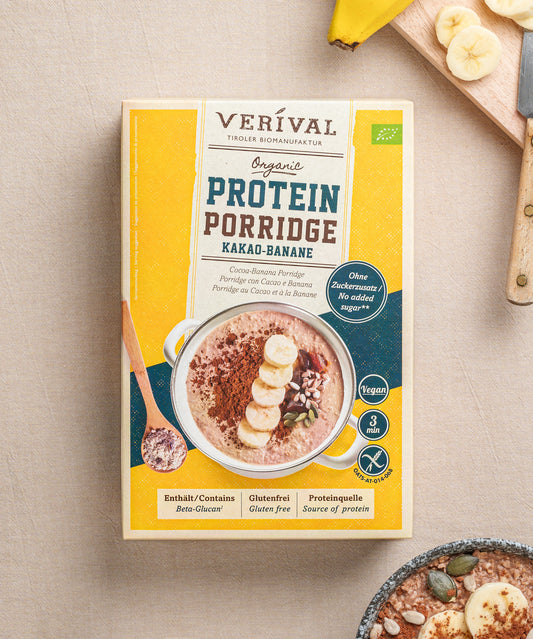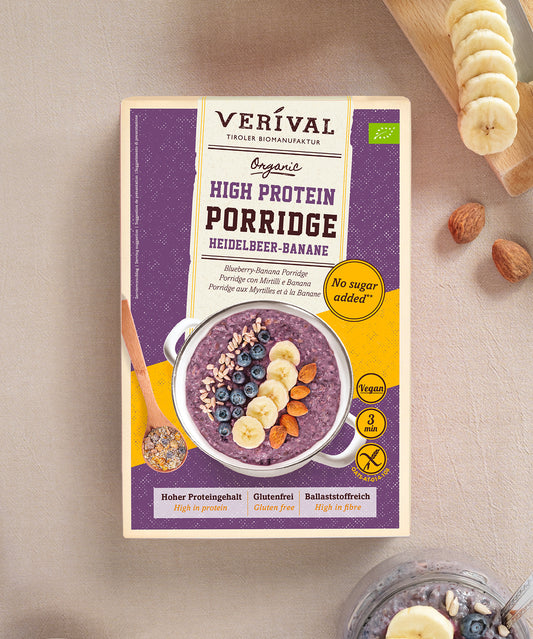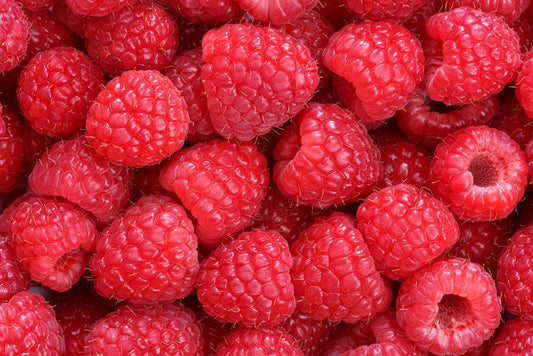The element magnesium is probably familiar to everyone. Even though most people know at least a little about the mineral, they often lack precise information about it.
Do you know, for example, what magnesium is good for, how you can tell if you have a magnesium deficiency, or which foods contain a lot of magnesium?
Sometimes it's not that easy to keep track of all the details. That's why we want to help with this article and introduce you to the various exciting aspects of the mineral magnesium. You will also find answers to the most frequently asked questions on the subject.
It's worth reading to the end, because there you will find out which Verival products contain a lot of magnesium. Would you have guessed it? As a little teaser, we can tell you that, among other things, oats and thus our porridges contain a particularly large amount of the mineral.
Find out more about Verival porridges.
What are nutrients?
In order for the body to be able to perform all its functions, it needs sufficient energy in the form of food. These nutrients are in turn composed of carbohydrates, fats, proteins, vitamins, dietary fibre, minerals and water.
Furthermore, the food components can be divided into non-essential and essential ones. The difference is that the body can synthesize some non-essential components itself, while essential components must be supplied with the food.
The food components that must be ingested with food include vitamins, minerals and some fatty acids and amino acids . 1 That is why it is all the more important to eat a healthy and balanced diet and thus supply the body with essential nutrients.
How many nutrients do I need? Overview of reference values
You may be wondering how much of each nutrient you need to consume and how high your energy requirement is. This varies depending on your sex, age, physical activity and individual factors such as certain pre-existing conditions. 1
For an adult with a basic requirement of 2,000 kcal, the European Union recommends the following composition. 2
| Energy or nutrient | Reference quantity |
| Energy | 8,400 kJ / 2,000 kcal |
| Fat | 70 g |
| Saturated Fatty Acid | 20 g |
| Carbohydrates | 260 g |
| Sugar | 90 g |
| Protein | 50 g |
| Salt | 6g |
Do you want to determine your individual calorie requirement? Then simply try out our calorie calculator.
These are the functions magnesium has in your body
Magnesium is one of the minerals, along with iron, zinc, sodium and potassium, among others. It is particularly important for the brain, heart and skeletal muscles because, among other things, it has anti-inflammatory properties. Above all, the substance is needed for the processes in the cell, such as energy metabolism, or the stability of DNA. 3
In the body, 50-60% of magnesium is found in the bones, about 40% in certain tissues and 1% in the blood. 3
However, not all of the magnesium that is ingested is absorbed by the body. With a supply of 400 mg magnesium /day, only 30-50% is actually absorbed by the intestines . 3 Thus, one can say that the body gets what it needs.
But other nutrients can also influence how much magnesium is actually absorbed. Experiments have shown that a very high intake of fiber and zinc and a low intake of proteins can inhibit the absorption of magnesium. 3
The effects of magnesium
As already mentioned, magnesium fulfills many different functions in the body. Numerous studies have shown a connection between magnesium and the cardiovascular system. For example, in a long-term study, the risk of high blood pressure was reduced by taking magnesium. 4
And the athletes among you probably also know magnesium for the treatment and prevention of calf cramps (muscle cramps in general).
In order for the body to perform the functions just mentioned, a certain amount of the nutrient must also be supplied to meet the daily requirement. How much that is depends on age, gender and individual factors such as pregnancy or breastfeeding. The older you get, the less magnesium can be absorbed through food. The following table provides an overview of the adequate magnesium requirement per day in mg. 3
| Age Group | Female | Male |
| 1 to < 4 years | 80 | 80 |
| 4 to < 10 years | 120 – 170 | 120 – 170 |
| 10 to < 19 years | 250 – 350 | 230 – 400 |
| 19 to < 51 | 350 – 310 | 400 – 450 |
| from 51 | 300 | 450 – 350 |
| Pregnant/breastfeeding women | 310 – 390 | – |
What happens if I take in too much magnesium?
First the good news: an increased magnesium level in the blood, also known as hypermagnesemia, cannot occur as a result of consuming magnesium-rich foods. However, if the recommended additional maximum daily dose of 250 mg is exceeded when taking magnesium in the form of dietary supplements, this can have unpleasant consequences such as nausea, vomiting or diarrhea. 5 In addition, high magnesium levels can also be a symptom of some diseases.
A low magnesium level, known as hypomagnesemia, can have various causes:
- Certain inflammatory diseases in the gastrointestinal tract (such as Crohn's disease, celiac disease, etc.) and kidneys
- Poor diet: too much fat and sugar and too few nuts, green vegetables and whole grains
- Increased requirement: for example when participating in competitive sports or during pregnancy
- Taking certain medications, including those to lower blood pressure or protect the stomach 6
The consequences of a slight deficiency can include tiredness, depressive moods or subjectively perceived muscle weakness. 3 However, this does not mean that if you experience any of these symptoms, you automatically have a magnesium deficiency – these can be the signs. If you suspect you have a deficiency, it is therefore advisable to visit a doctor to clarify the next steps.
Self-diagnosis and taking dietary supplements is not recommended. This is because a 2020 study by the German consumer organization found that 57% of magnesium-containing foods exceeded the maximum recommended daily dose in dietary supplements. 7 And you already know what this entails in terms of side effects.
Which foods are high in magnesium?
Magnesium is found in many, mainly plant-based foods. As a rule of thumb, nuts, whole grain products, legumes (such as chickpeas or soybeans) and green vegetables (such as Swiss chard, broccoli, stinging nettle) are particularly rich in magnesium.
This means that if you frequently eat grain products such as whole grain bread or whole grain pasta, you are already doing a lot of good for your magnesium supply. Drinking water also provides more magnesium with an increasing degree of hardness. 5 The more processed foods are (e.g. ready meals), the lower the magnesium concentration. 3
Of course, dairy products also contain magnesium – albeit in smaller quantities.
The following foods have a high magnesium content. 3,8
| Source | Magnesium content (mg/100g) |
| Pumpkin seeds | 400 |
| Flaxseed | 350 |
| Sunflower seeds | 325 |
| Cashews | 300 |
| Wheat bran | 235 |
| Bitter chocolate | 250 |
| Almonds | 220 |
| Oats | 130 |
Worth knowing: cocoa powder (unsweetened and de-oiled) is also extremely rich in magnesium – so when we reach for chocolate, it's best to go for dark chocolate with at least 70 percent cocoa.
Nuts
As already mentioned, nuts are also foods that are extremely rich in magnesium. And there are many different types: simply add peanuts or cashew nuts to your muesli or porridge. Walnuts or hazelnuts are also great sources of magnesium when nibbled.
Pumpkin seeds
Pumpkin seeds are the real champions when it comes to covering your daily magnesium needs. By occasionally nibbling on a handful of seeds or sprinkling them over salad and soup, you can easily incorporate a magnesium-rich food into your diet. Pregnant and breastfeeding women, adolescents and athletes have an increased magnesium requirement and should not go without this delicious snack.
Sunflower seeds
These seeds also have a very high magnesium content. They should never be missing from your balanced diet in bread, muesli or porridge.
Wheat bran
Wheat bran remains after the flour has been sieved during grain processing. This fiber-rich by-product of flour production is one of the foods that is extremely rich in magnesium. It tastes slightly nutty and bitter.
Oats as a source of magnesium
In addition to a high magnesium content, oats offer other advantages. The flakes have a high proportion of the water-soluble fiber beta-glucan. This lowers blood sugar and cholesterol levels and can help prevent cardiovascular diseases. They are also a vegetable source of protein and contain numerous other minerals such as iron, zinc and phosphorus. This makes oats an ideal healthy breakfast cereal! Sprinkled with a few blackberries, sesame seeds or linseed, this magnesium bomb is perfect.
Below you will learn how to easily make a quick oat porridge for a healthy breakfast!
Verival porridges as an ideal source of magnesium
At VERIVAL, we carry out regular tests to ensure that our products meet our high quality criteria. We also have the nutritional values tested and are proud to present the results to you.
Our Sport Protein Porridge Chocolate Banana is the absolute front-runner, containing a full 169mg of magnesium per 100g of porridge. Wholegrain oats, sunflower seeds, pumpkin seeds and dark chocolate pieces are responsible for the high content. This means that just one portion (45g) covers 20% of your daily requirement! *
And our other products, such as the strawberry chia porridge or the Bircher porridge, are also good sources of magnesium thanks to high-quality and, as far as possible, unprocessed ingredients.
- *The daily reference value used here is 350 mg/day.
- Huppelsberg W. Kurzlehrbuch Physiologie. 1st ed. Thieme; 2003.
- Document 02011R1169. EUR-Lex. Published January 1, 2018. Accessed June 10, 2021. https://eur-lex.europa.eu/legal-content/EN/TXT/?uri=CELEX%3A02011R1169-20180101
- Biesalski HK. Vitamins, trace elements and minerals. Indication, diagnosis, therapy. 2nd ed. Thieme; 2019.
- Abbott RD, Ando F, Masaki KH, et al. Dietary magnesium intake and the future risk of coronary heart disease (The Honolulu Heart Program). The American Journal of Cardiology. Published online September 2003:665-669. doi: 10.1016/s0002-9149(03)00819-1
- Magnesium – was ist zu beachten? Verbraucherzentrale. Published March 23, 2021. Accessed June 10, 2021. https://www.verbraucherzentrale.de/wissen/lebensmittel/nahrungsergaenzungsmittel/magnesium-was-ist-zu-beachten-8003
- Magnesium. DocCheck Flexikon. Published 2021. Accessed June 11, 2021. https://flexikon.doccheck.com/de/Magnesium
- Magnesium-containing dietary supplements: often overdosed! Consumer Advice Center; 2020:3. Accessed June 11, 2021. https://www.klartext-nahrungsergaenzung.de/sites/default/files/2021-02/Marktcheck_Magnesium_2020.pdf
- Nutritional tables for rolled oats and oat bran. Oats The All-Grains. Published 2021. Accessed June 11, 2021. https://www.alleskoerner.de/ernaehrung/naehrstoffe/naehrwerttabelle





